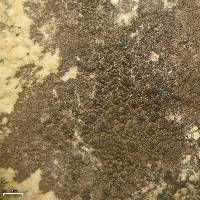
Consortium of Lichen Herbaria
- building a Global Consortium of Bryophytes and Lichens as keystones of cryptobiotic communities -
- Home
- Search
- Images
- Species Checklists
- US States: O-Z >
- US National Parks
- Central America
- South America
- US National Parks
- Southern Subpolar Region
|
|
|
|
Family: Verrucariaceae
|
Nash, T.H., Ryan, B.D., Gries, C., Bungartz, F., (eds.) 2007. Lichen Flora of the Greater Sonoran Desert Region. Vol 3. Thallus: areolate, 0.2-0.3 mm thick, without a black basal layer, with or without a prothallus forming a thin black-brown, peripheral line areoles: angular to irregular in outline, plane or slightly convex when fertile, 0.2-0.5(-0.7) mm wide, with subacute to blunt fissures, ±secondarily divided into smaller areoles surface: grayish brown to dark brown, dull anatomy: upper cortex: hardly delimited, composed of 1-3 layers of cells c. 5 µm in diam., with an uppermost brown cell layer; algal layer: paraplectenchymatous, 80-150 µm thick, with algal cells 7-10 µm in diam.; alga-free medulla: subparaplectenchymatous, with rock fragments and crystals, colorless or patchily brown (especially around perithecia) Perithecia: single per areole, immersed to hemispherically prominent, originating in the center of areoles, often becoming (sub)marginal by secondarily cracking of the areole, with a thalline covering up to near apex when young, later erumpent and largely bare; exciple: broadly pyriform, 0.25-0.40 mm wide, brownish to darker brown; involucrellum: extending to exciple-base level, contiguous with exciple, apically compact, broadening to 75-100(-120) µm thick at lower half and here somewhat diffusely delimited, with crystal inclusions, merging with brown medullary tissue; periphyses 25-35 µm long, 2-2.5 µm thick asci: broadly clavate, 70-95 x 25-30 µm, 8-spored ascospores: hyaline, simple, ellipsoid, 22-30(-35) x (9-)10-13(-15) µm Spot tests: all negative Secondary metabolites: none detected. Substrate and ecology: epilithic, on siliceous or slightly calciferous rocks (gneiss, granite, volcanic rock, sandstone) World distribution: Europe and North America Sonoran distribution: rather widely distributed and apparently frequent in Arizona (Cochise, Coconino, Gila, Maricopa, Pima, and Pinal Counties), and southern California (San Diego, San Bernardino, Orange, and Ventura Counties). Notes: There should exist an older name for this species, but the taxonomy of the brown, thickly epilithic species is not yet clarified. Verrucaria nigrofusca is almost identical in habitus and anatomy, but differs in smaller perithecia and spores. Verrucaria endocarpoides is distinct in its combination of shorter, thickish periphyses, immersed perithecia with thinner involucrella, and narrower spores. |
Powered by Symbiota

















